Excerpts from Jim Conrad's
Naturalist Newsletter

It was a young Yellow-red Ratsnake, PSEUDELAPHE FLAVIRUFA. One nice feature of the above photo is that is shows so nicely the typical ratsnake flat bottom. If you make a cross section of a ratsnake it'll be shaped like a slice of bread, rounded on top, with flat sides and a flat bottom. As you'd expect, right angles are formed where the flat sides and flat bottom come together. These sharp angles help the snake keep its grip while climbing among tree limbs.
My herp book says that this species is distributed from central Mexico to Nicaragua, but that throughout its range it doesn't seem to be common anywhere. It occupies many habitats, though, from very dry forests to tropical wet ones, and it has been found eating rodents, bats, birds and lizards. When Katharine heard this she decided that this may be the reason why mice hadn't been a plague in that particular building.
When Doña Lupe the maid saw the snake she confidently pronounced it a young rattlesnake, no doubt about it. I suspect that the vast majority of folks here would have said the same, and they would have dispatched the pretty snake forthwith. The Doña didn't seem too pleased when we released our find into a nearby stone wall.
Several flat-bottomed ratsnakes of the genus Elaphe occur in North America. I have a friend in Kentucky who named his kids after snake genera and one of them is called Elaphe. Ratsnakes will bite you if you bother them, though of course their bite is not venomous. This little fellow tried to bite me but I don't think his small teeth could have done much damage. The species grows to five feet or more, however, and I wouldn't carelessly handle one of that size.
from the April 3, 2016 Newsletter issued from Hacienda Chichen Resort beside Chichén Itzá Ruins, central Yucatán, MÉXICO; limestone bedrock, elevation ~39m (~128ft), ~N20.676°, ~W88.569°
A SNAPPY YELLOW-RED RATSNAKE
Accompanying some folks from Utah during the afternoon walk, our trail beneath the big Piich Tree next to the banana plantation was blocked by a little snake about 15 inches long (38cm). This delighted the Utahans, who'd been looking for snakes during their vacation, but had seen none. I could tell them outright that we had a Yellow-red Ratsnake, for we've encountered and photographed this species several times.
This individual displayed behavior not seen during previous encounters. Namely, when I got down on my hands and knees and focused the camera on him, he coiled into a pretzel shape, inflated his head into a cobra-like triangular shape, and jumped at me with his white mouth wide open, like an angry Water Moccasin back in Mississippi. Below, you can see him the instant before his lunge:
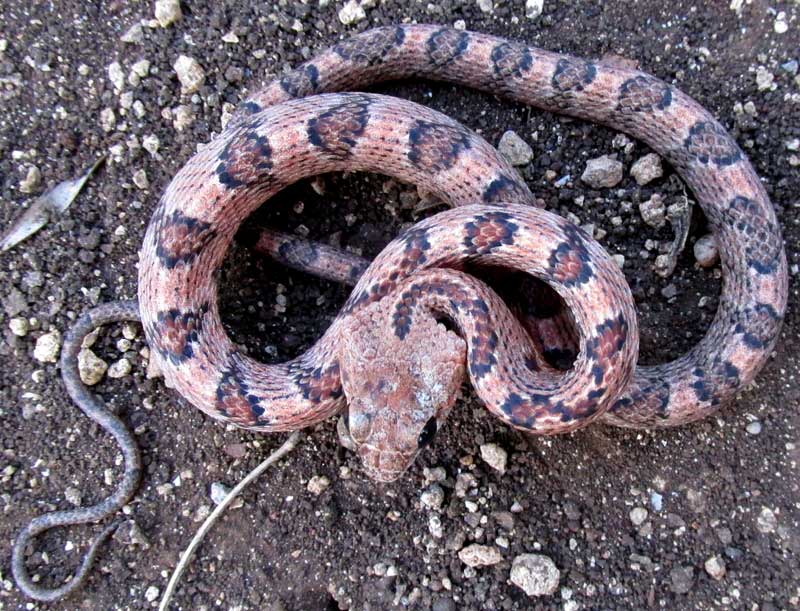
The poor thing looked a bit skinny but I had to admire his chutzpah. During earlier encounters I'd gotten the impression that the species was halfway docile, but not this one.
The irregularly shaped diamonds across the back that are reddish with black margins, and the black line atop the spine extending onto the back of the head, are fairly good field marks. However, once we found one over a yard long (1m) and its splotches were more irregularly shaped and uniformly brown instead of red and black.
The one in our photograph wasn't far from a spot undermined by many tunnels made by pocket gophers called Tuzas. The Tuzas threaten our banana trees, for Tuzas love to come up under a tree, eating roots and lower stem as they do so, until one day the tree simply falls over, rootless and dead. Our Yellow-red Ratsnake could benefit from eating some of those Tuzas, and so would the banana trees.
adapted from the September 15, 2008 Newsletter written in Sabacché, Yucatán, MÉXICO
elevation ~10m ~33 ft, N20.659°, W89.370°
YELLOW-RED RATSNAKE
The other morning while jogging at dawn I found a snake between three and four feet long belly-up along the road. It had been shot through the head. It was so large and heavy that, with its bold blotching, in the morning twilight I thought it was a Boa Constrictor, a species fairly common in the Yucatán. However, back home and with more light it was clearly not a Boa. The shape of the head was all wrong, its pupils were circular, not "cat-eyed" like a Boa's, and the head scales were large, not tiny as a Boa's. You can see it below:
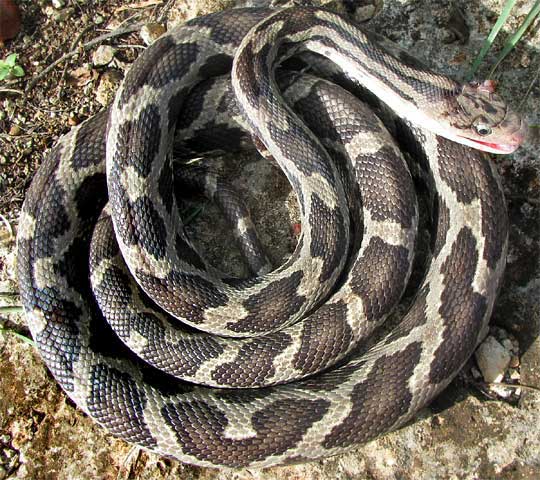
The unknown snake has a divided anal plate, as shown below:
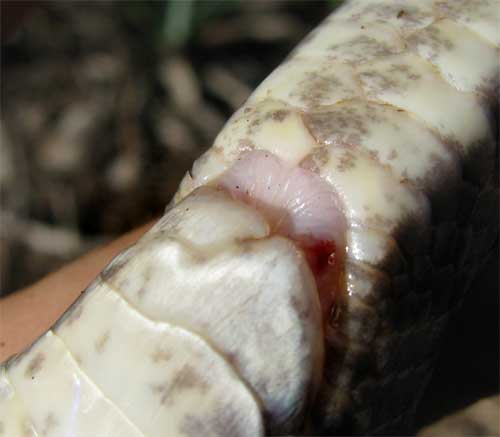
The bottom is white, with small blotches along the edge:
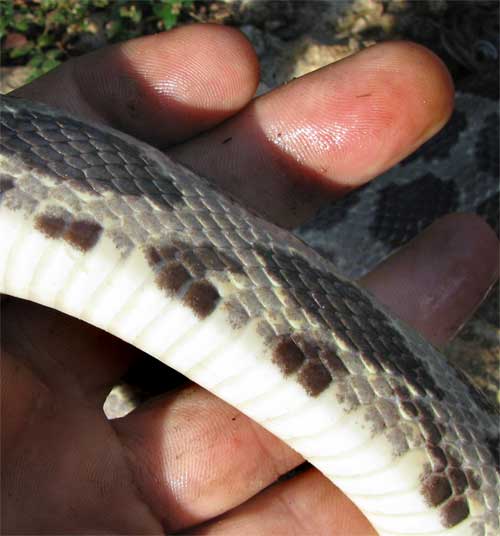
issued on March 9, 2020 from the forest just west of Tepakán; elev. ~9m (~30 ft), N21.053°, W89.052°; north-central Yucatán state, MÉXICO
SNAKE AT DAWN
At dawn when there was just enough light to dress and go jogging, I was moving some pots on the outside kitchen table when a snake quickly uncoiled from behind one of them. He was very willing to snap at me. Still, I grabbed him and despite having to use a shutter speed of half a second because of the dim light, got the picture shown below:
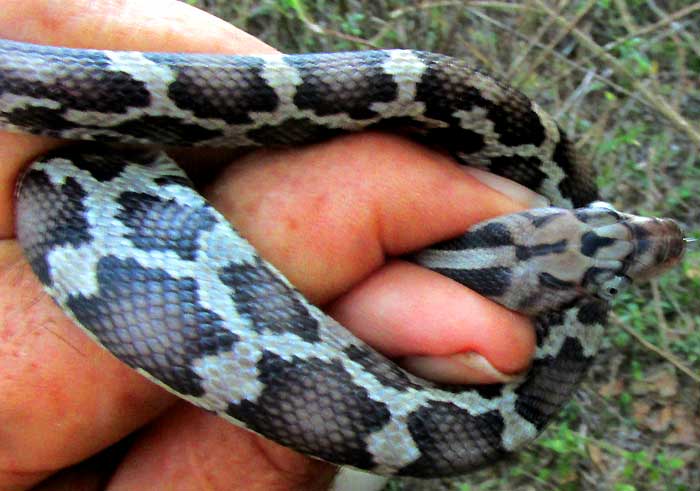
It looked like a Yellow-red Rat Snake, seen several times before, but the species is so similar to our Yucatan phase of the Common Tropical Ratsnake that I took more pictures, hoping to clear things up. A shot of the side and the head's underside is shown below:

And the head close-up, from the side:
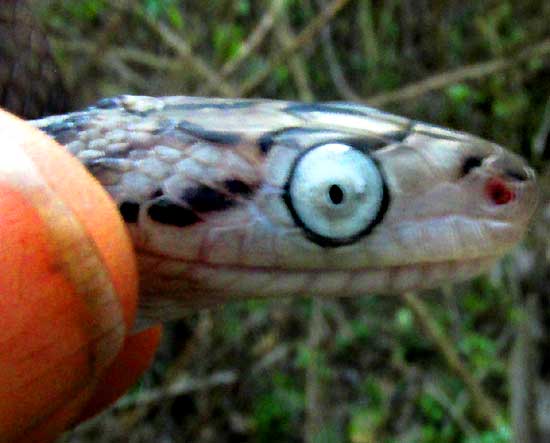
In Jonathan Campbell's Amphibians and Reptiles of Northern Guatemala, the Yucatán, and Belize, the printed key to snakes has the Common Tropical Ratsnake and the Yellow-red Ratsnake keying out together, so Campbell finds them similar, too. His key characters distinguishing them are that the Common Tropical Ratsnake's blotches are grayish to tan, and usually there are 8 scales above the mouth (supralabials), while the Yellow-red Ratsnake's blotches are reddish, and usually there are 9 supralabials. In the dim morning light the blotches were a bit reddish.
The species occurs from central and southern Mexico south into Nicaragua. All my spottings have been of younger snakes averaging maybe 2ft long, but I read that they can reach 4ft (1.2m). Some authorities have recognized five forms, including the Yucatan Ratsnake, Elaphe flavirufa phaescens, but now The Reptile Database recognizes only three subspecies, of which the Yucatan form is not represented.